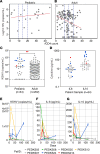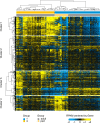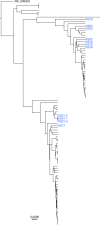Pediatric HIV+ Kaposi sarcoma exhibits clinical, virological, and molecular features different from the adult disease
- PMID: 37991023
- PMCID: PMC10721314
- DOI: 10.1172/jci.insight.167854
Pediatric HIV+ Kaposi sarcoma exhibits clinical, virological, and molecular features different from the adult disease
Abstract
BACKGROUNDKaposi sarcoma (KS) is among the most common childhood cancers in Eastern and Central Africa. Pediatric KS has a distinctive clinical presentation compared with adult KS, which includes a tendency for primary lymph node involvement, a considerable proportion of patients lacking cutaneous lesions, and a potential for fulminant disease. The molecular mechanisms or correlates for these disease features are unknown.METHODSThis was a cross-sectional study. All cases were confirmed by IHC for KS-associated herpesvirus (KSHV) LANA protein. Baseline blood samples were profiled for HIV and KSHV genome copy numbers by qPCR and secreted cytokines by ELISA. Biopsies were characterized for viral and human transcription, and KSHV genomes were determined when possible.RESULTSSeventy participants with pediatric KS were enrolled between June 2013 and August 2019 in Malawi and compared with adult patients with KS. They exhibited high KSHV genome copy numbers and IL-6/IL-10 levels. Four biopsies (16%) had a viral transcription pattern consistent with lytic viral replication.CONCLUSIONThe unique features of pediatric KS may contribute to the specific clinical manifestations and may direct future treatment options.FUNDINGUS National Institutes of Health U54-CA-254569, PO1-CA019014, U54-CA254564, RO1-CA23958.
Keywords: AIDS/HIV; Cancer; Kaposi sarcoma; Oncology.
Figures





References
-
- Centers for Disease Control (CDC) Kaposi’s sarcoma and Pneumocystis pneumonia among homosexual men--New York City and California. MMWR Morb Mortal Wkly Rep. 1981;30(25):305–308. - PubMed
Publication types
MeSH terms
Grants and funding
LinkOut - more resources
Full Text Sources
Medical

